
The Brassicales are an order of flowering plants, belonging to the eurosids II group of dicotyledons under the APG II system. One character common to many members of the order is the production of glucosinolate compounds. Most systems of classification have included this order, although sometimes under the name Capparales.
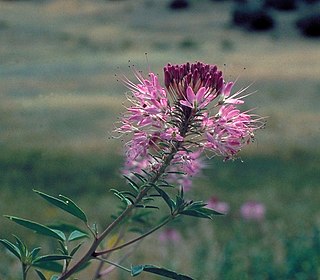
Cleome serrulata, commonly known as Rocky Mountain beeplant/beeweed, stinking-clover, bee spider-flower, skunk weed, Navajo spinach, and guaco is an annual plant in the genus Cleome. Many species of insects are attracted to it, especially bees, which helps in the pollination of nearby plants. It is native to southern Canada and western and central United States. This plant has often been used for food, to make dyes for paint, and as a treatment in traditional medicine.

The Capparaceae, commonly known as the caper family, are a family of plants in the order Brassicales. As currently circumscribed, the family contains 33 genera and about 700 species. The largest genera are Capparis, Maerua, Boscia and Cadaba.
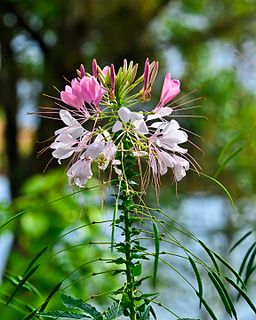
Cleome is a genus of flowering plants in the family Cleomaceae, commonly known as spider flowers, spider plants, spider weeds, or bee plants. Previously, it had been placed in the family Capparaceae, until DNA studies found the Cleomaceae genera to be more closely related to the Brassicaceae than the Capparaceae. Cleome and clammyweed, can sometimes be confused. The simplest way to differentiate the two is to compare the seedpods which project out or down on cleome and up on clammyweed.
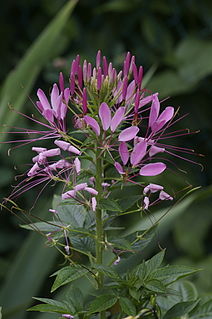
Cleome hassleriana, commonly known as spider flower, spider plant, pink queen, or grandfather's whiskers, is a species of flowering plant in the genus Cleome of the family Cleomaceae, native to southern South America in Argentina, Paraguay, Uruguay, and southeast Brazil. It has also been introduced to South Asia, including the Haor area of Bangladesh.

The Cleomaceae are a small family of flowering plants in the order Brassicales, comprising about 300 species in 10 genera, or about 150 species in 17 genera. These genera were previously included in the family Capparaceae, but were raised to a distinct family when DNA evidence suggested the genera included in it are more closely related to the Brassicaceae than they are to the Capparaceae. The APG II system allows for Cleomaceae to be included in Brassicaceae.

Podandrogyne is a genus of flowering plants in the family Cleomaceae. They are closely related to genus Cleome.

Cleomella is a small genus of about ten species of flowering plants. Like their relatives, the cleomes, plants of this genus have traditionally been included in the caper family Capparaceae but have recently been moved into a new family, Cleomaceae. Cleomella are annual wildflowers native to the dry and desert regions of western North America. They are similar to cleomes in appearance. They are erect and branching with leaves divided into three leaflets and inflorescences of yellow flowers with long stamens. Cleomella species are known commonly as stinkweeds or simply cleomellas.

Cleome gynandra is a species of Cleome that is used as a green vegetable. It is known by many common names including Shona cabbage, African cabbage, spiderwisp, cat's whiskers, chinsaga and stinkweed. It is an annual wildflower native to Africa but has become widespread in many tropical and sub-tropical parts of the world. It is an erect, branching plant generally between 25 cm and 60 cm tall. Its sparse leaves are each made up of 3–5 oval-shaped leaflets. The flowers are white, sometimes changing to rose pink as they age. The seed is a brown 1.5 mm diameter sphere. The leaves and flowers are both edible. The leaves have a strong bitter, sometimes peppery flavor similar to mustard greens.

Cleome ornithopodioides or bird spiderflower is the type species of the genus Cleome which is part of the family Cleomaceae or Brassicaceae. The species epithet means "birds-foot like".
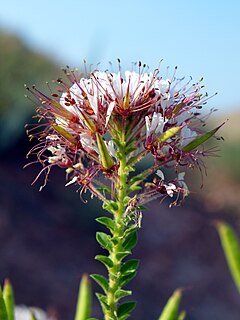
Polanisia dodecandra is a species of flowering plant in the Cleomaceae family, known by the common name redwhisker clammyweed or clammyweed, and there are three subspecies of Polanisia. Usually annual, occasionally perennial, Polanisia is native to North America, and is found throughout much of Canada and the United States. It favors full sun, mesic to dry conditions, and barren, sandy or gravelly soils, even highly disturbed areas where there is little other ground vegetation. It looks similar to a close relative, the spider flower (Cleome).
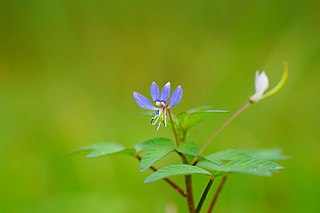
Cleome rutidosperma, commonly known as fringed spider flower or purple cleome, is a species of flowering plant in the genus Cleome of the family Cleomaceae, native to tropical Africa. This species is an invasive weed throughout most lowland wet tropical areas of Asia and Australia. It is a very common weed of lawns.

Cleome viscosa, the Asian spiderflower or tick weed is an annual herb that grows up to a meter high. It belongs to the family Cleomaceae. It's considered an invasive species and it is widely distributed in warm and humid habitats across the Americas, Africa and Asia. It is commonly found during the rainy season.
Cleome arenitensis is a species of plant in the Cleomaceae family and is found in Western Australia.
Cleome cleomoides, commonly known as Justago, is a species of plant in the Cleomaceae family and is found in Western Australia.
Cleome kenneallyi is a species of plant in the Cleomaceae family and is found in Western Australia.
Cleome tetrandra is a species of plant in the Cleomaceae family and is found in Western Australia.
Cleome uncifera is a species of plant in the Cleomaceae family and is found in Western Australia.
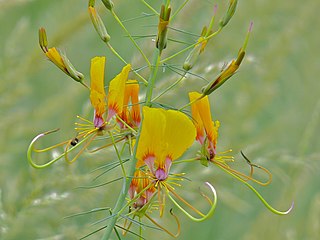
Cleome angustifolia, known as golden cleome, yellow cleome or yellow mouse whiskers, is an African species of plant in the Cleomaceae family. It is common along roadsides and in disturbed areas and is eaten as vegetable locally. Swedish naturalist Peter Forsskål described C. angustifolia in 1775. It is one of three species in genus Cleome (the others being C. gynandra and C. oxalidea) that independently acquired the C4 pathway of carbon fixation. A species close to C. angustifolia, Cleome paradoxa, is C3–C4 intermediate.













